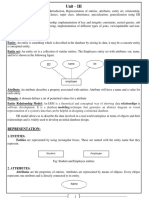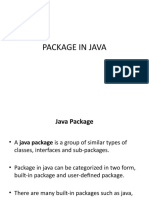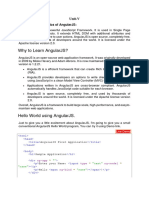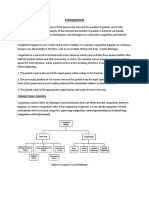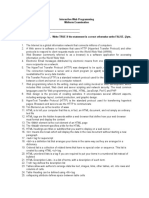Module 3-1
Uploaded by
mbs.vinodModule 3-1
Uploaded by
mbs.vinodWeb Application and Development MMC205
Module 3
Introduction to JavaScript
J avascriptisadynamiccomputerprogramminglanguage.Itislightweightandmostcommonlyusedas
apartofwebpages,whoseimplementationsallowclient-sidescriptstointeractwiththeuserandmake
dynamic pages. It is an interpreted programming language with object-oriented capabilities.
Advantages
● L
ess server interaction − You can validate user input before sending the page off to the server.
This saves server traffic, which means less load on your server.
● I mmediate feedback to the visitors − They don't have to wait for a page reload to see if they
have forgotten to enter something.
● I ncreased interactivity − You can create interfaces that react when the user hovers over them
with a mouse or activates them via the keyboard.
● R
icher interfaces − You can use JavaScript to include such items as drag-and-drop components
and sliders to give a Rich Interface to your site visitors.
Data Types
JavaScript allows you to work with three primitive data types
● Numbers, eg. 123, 120.50 etc.
● Strings of text e.g. "This text string" etc.
● Boolean e.g. true or false.
Trivial data types
null and undefined, each of which defines only a single value
ATME College of Engineering Department of MCA 1
Web Application and Development MMC205
composite data type object
Variables
ariables are declared with the var keyword as follows. JavaScript is untyped language. This means
V
that a JavaScript variable can hold a value of any data type.
You can also declare multiple variables with the same var keyword as follows −
Storing a value in a variable is called variable initialization.
JavaScript Variable Scope
he scope of a variable is the region of your program in which it is defined. JavaScript variables have
T
only two scopes.
● G
lobal Variables− A global variable has global scopewhich means it can be defined
anywhere in your JavaScript code.
ATME College of Engineering Department of MCA 2
Web Application and Development MMC205
● L
ocal Variables− A local variable will be visibleonly within a function where it is defined.
Function parameters are always local to that function.
ithin the body of a function, a local variable takes precedence over a global variable with the same
W
name.
This produces the following result −
Operators
What is an operator?
et us take a simple expression 4 + 5 is equal to 9. Here 4 and 5 are called operands and ‘+’ is called the
L
operator. JavaScript supports the following types of operators.
● Arithmetic Operators
● Comparison Operators
● Logical (or Relational) Operators
● Assignment Operators
● Conditional (or ternary) Operato
ATME College of Engineering Department of MCA 3
Web Application and Development MMC205
Types of Operators in JavaScript
JavaScript provides several categories of operators to perform various types of operations. These are:
1. Arithmetic Operators
These operators perform basic mathematical calculations.
Operator Description Example
+ Addition 4 + 5 = 9
- Subtraction 9 - 4 = 5
* Multiplication 3 * 4 = 12
/ Division 10 / 2 = 5
% Modulus (Remainder) 7 % 3 = 1
++ Increment (adds 1) x++ increases x by 1
-- Decrement (subtracts 1) x-- decreases x by 1
Explanation:
Arithmetic operators are the most fundamental operators and allow for numerical calculations within
JavaScript programs. Increment and decrement operators are shorthand for increasing or decreasing a number
by one and are often used in loops.
2. Comparison Operators
These operators compare two values and return a Boolean result — either true or false.
Operator Description Example
== Equal to 5 == '5' returns true
ATME College of Engineering Department of MCA 4
Web Application and Development MMC205
=== Strict equal (value & type) 5 === '5' returns false
!= Not equal to 4 != 5 returns true
!== Strict not equal 4 !== '4' returns true
> Greater than 7 > 3 returns true
< Less than 2 < 5 returns true
>= Greater than or equal to 4 >= 4 returns true
<= Less than or equal to 3 <= 5 returns true
Explanation:
Comparison operators are essential for making decisions in code, such as in if statements or loops. The strict
equality operators (===and!==) check both valueand type, avoiding unexpected type coercion.
3. Logical (Relational) Operators
Logical operators combine multiple Boolean expressions and return Boolean values.
Operator Description Usage Example
&& Logical AND true && false returns false
|| Logical OR true || false returns true
! Logical NOT (negation) !true returns false
Explanation:
Logical operators are used to evaluate complex conditions involving more than one criterion. For example,
checking if two conditions are both true (&&), ifat least one is true (||), or negating a Boolean expression(! ).
4. Assignment Operators
Assignment operators are used to assign values to variables, often combining arithmetic operations.
ATME College of Engineering Department of MCA 5
Web Application and Development MMC205
Operator Description Example
= Simple assignment x = 5 assigns 5 to x
+= Add and assign x += 3 is equivalent to x = x + 3
-= Subtract and assign x -= 2 is equivalent to x = x - 2
*= Multiply and assign x *= 4 is equivalent to x = x * 4
/= Divide and assign x /= 2 is equivalent to x = x / 2
%= Modulus and assign x %= 3 is equivalent to x = x % 3
Explanation:
Assignment operators simplify expressions where a variable’s value needs to be updated based on its current
value. They make code shorter and more readable.
5. Conditional (Ternary) Operator
he conditional operator is a compact form of an if-else statement that evaluates a condition and returns one of
T
two values based on whether the condition is true or false.
Syntax:
condition ? value_if_true : value_if_false
Explanation:
It is useful for concise conditional assignments or expressions where a simple decision is needed. It helps keep
the code clean and minimizes the number of lines, especially for straightforward conditions.
Summary
Operator Type Purpose Returns
Arithmetic Operators Perform mathematical calculations Numeric values
Comparison Operators Compare two values Boolean (true/false)
ATME College of Engineering Department of MCA 6
Web Application and Development MMC205
Logical Operators Combine Boolean expressions Boolean (true/false)
Assignment Operators Assign or update variable values Assigned value
Conditional (Ternary) Operator hoose between two values based on One of two values
C
condition
Control Statements
It used to control the flow of execution within a program .Two types
1. Conditional
Decision Making Statement Loop Control Statement
1.if statement 1.while
2.if .. else statement 2. do – while
3.if – else – if statement 3. for
4.switch 4. for – in
2. Unconditional
1. break
2. continue
3. goto
ATME College of Engineering Department of MCA 7
Web Application and Development MMC205
if statement
he if statement is the fundamental control statement that allows JavaScript to make decisions and
T
execute statements conditionally.
Syntax
The syntax for a basic if statement is as follows −
ere a JavaScript expression is evaluated. If the resulting value is true, the given statement(s) are
H
executed. If the expression is false,thennostatementwouldbenotexecuted.Mostofthetimes,you
will use comparison operators while making decisions.
Example
Try the following example to understand how the if statement works.
Output
ATME College of Engineering Department of MCA 8
Web Application and Development MMC205
if...else statement:
he 'if...else' statement is the next form of control statement that allows JavaScript to execute statements in
T
a more controlled way.
Syntax
ereJavaScriptexpressionisevaluated.Iftheresultingvalueistrue,thegivenstatement(s)inthe‘if’
H
block, are executed. If the expression is false, then the given statement(s) in the else block are
executed.
Example
Try the following code to learn how to implement an if-else statement in JavaScript.
ATME College of Engineering Department of MCA 9
Web Application and Development MMC205
Output
if...else if... statement
he if...else if... statement is an advanced form of if…else that allows JavaScript to make a correct decision
T
out of several conditions.
Syntax
The syntax of an if-else-if statement is as follows −
hereisnothingspecialaboutthiscode.Itisjustaseriesofifstatements,whereeachifisapartofthe
T
elseclauseofthepreviousstatement.Statement(s)areexecutedbasedonthetruecondition,ifnoneof
the conditions is true, then the else block is executed.
Example
Try the following code to learn how to implement an if-else-if statement in JavaScript.
ATME College of Engineering Department of MCA 10
Web Application and Development MMC205
Output
Switch Statement
heobjectiveofaswitchstatementistogiveanexpressiontoevaluateandseveraldifferentstatements
T
to executebasedonthevalueoftheexpression.Theinterpretercheckseachcaseagainstthevalueof
the expression until a match is found. If nothing matches, a default condition will be used.
ATME College of Engineering Department of MCA 11
Web Application and Development MMC205
he break statements indicate the end of a particular case. If they were omitted, the interpreter would
T
continue executing each statement in each of the following cases.
We will explain break statement inLoop Controlchapter.
Example
Try the following example to implement switch-case statement.
Output
ATME College of Engineering Department of MCA 12
Web Application and Development MMC205
Looping Statements
hilewritingaprogram,youmayencounterasituationwhereyouneedtoperformanactionoverand
W
over again. In such situations, you would need to write loop statements to reduce the number of lines.
The while Loop
he most basic loop in JavaScript is the while loop which would be discussed in this chapter. The
T
purposeofawhileloopistoexecuteastatementorcodeblockrepeatedlyaslongasanexpressionis
true. Once the expression becomes false, the loop terminates.
Syntax
The syntax of while loop in JavaScript is as follows −
Example
Try the following example to implement while loop.
ATME College of Engineering Department of MCA 13
Web Application and Development MMC205
Output
The do...while Loop
he do...while loop issimilartothewhileloopexceptthattheconditioncheckhappensattheendof
T
the loop. This means that the loop will always be executed at least once, even if the condition is false.
Syntax
The syntax for do-while loop in JavaScript is as follows −
Example
Try the following example to learn how to implement a do-while loop in JavaScript.
ATME College of Engineering Department of MCA 14
Web Application and Development MMC205
Output
For Loop
The 'for' loop is the most compact form of looping. It includes the following three important parts −
● T he loop initialization where we initialize our counter to a starting value. The initialization
statement is executed before the loop begins.
● T heteststatementwhichwilltestifagivenconditionistrueornot.Iftheconditionistrue,then
the code given inside the loop will be executed, otherwise the control will come out of the loop.
● Theiterationstatementwhereyoucanincreaseordecreaseyourcounter.You
can put all the three parts in a single line separated by semicolons.
ATME College of Engineering Department of MCA 15
Web Application and Development MMC205
Syntax
The syntax of for loop is JavaScript is as follows −
Example
Try the following example to learn how a for loop works in JavaScript.
Output
ATME College of Engineering Department of MCA 16
Web Application and Development MMC205
For – in
hefor...inloopisusedtoloopthroughanobject'sproperties.AswehavenotdiscussedObjectsyet,
T
you may not feel comfortable with this loop. But once you understand how objects behave in
JavaScript, you will find this loop very useful.
Syntax
I n each iteration, one property from object is assigned to variablename and this loop continues till all
the properties of the object are exhausted.
Example
ry the following example to implement ‘for-in’ loop. It prints the web
T
browser’s Navigator object.
ATME College of Engineering Department of MCA 17
Web Application and Development MMC205
Output
Functions
functionisagroupofreusablecodewhichcanbecalledanywhereinyourprogram.Thiseliminates
A
the need of writing the same code again and again. It helps programmers in writingmodularcodes.
Functions allow a programmer to divide a big program into a number of small and manageable
functions.
Function Definition
efore we use a function, we need to define it. The most common way to define a function in
B
JavaScriptisbyusingthefunctionkeyword,followedbyauniquefunctionname,alistofparameters
(that might be empty), and a statement block surrounded by curly braces.
Syntax
The basic syntax is shown here.
ATME College of Engineering Department of MCA 18
Web Application and Development MMC205
Example
Try the following example. It defines a function called sayHello that takes no parameters −
Calling a Function
o invoke a function somewhere later in the script, you would simply need to write the name of that
T
function as shown in the following code.
ATME College of Engineering Department of MCA 19
Web Application and Development MMC205
Output
Hello there!
Function Parameters
illnow,wehaveseenfunctionswithoutparameters.Butthereisafacilitytopassdifferentparameters
T
while calling a function. These passed parameters can be captured inside the function and any
manipulationcanbedoneoverthoseparameters.Afunctioncantakemultipleparametersseparatedby
comma.
Example
Try the following example. We have modified our sayHello function here. Now it takes two parameters.
The return Statement
JavaScript function can have an optional return statement. This is required if you want to return a value
A
from a function. This statement should be the last statement in a function.
ATME College of Engineering Department of MCA 20
Web Application and Development MMC205
or example, you can pass two numbers in a function and then you can expect the function to return
F
their multiplication in your calling program.
Example
ry the following example. It defines a function that takes two parameters and concatenates them before
T
returning the resultant in the calling program.
Document Object Model (DOM):
DOM stands for Document Object Model. But what does that mean? Let's break it down.
heDocumentpart refers to the webpage you see inthe browser. Specifically, the HTML Document which
T
handles the structure of the page's content. This includes the text, images, links, and other elements that make
up the page.
ATME College of Engineering Department of MCA 21
Web Application and Development MMC205
bjectmeans the elements like images, headers, and paragraphs are treated like objects. Each object has its
O
properties (like id, class, style) and methods. Using these properties and methods, you can manipulate the
elements.
heModelin DOM means it's a representation or copyof the HTML document as a hierarchical tree. This tree
T
includes all the elements. And it captures the parent-child relationships between them.
he DOM is always identical to the HTML document. Browsers ensure that they are in sync. So if something
T
changes in the HTML, the DOM changes too, and vice versa.
A graphical representation of the HTML DOM tree
t the top of the hierarchy is the Document object. It has only one child – thehtmlelement. Thehtmlelement,
A
also known as the root element, has two children, theheadandbodyelements. And each of them alsohave their
own children elements.
he parent-child relationship between the elements is what allows you to traverse or move between and select
T
them. More on that later.
Accessing DOM Elements
JavaScript provides various DOM Selection methods to access elements:
Method Description
ATME College of Engineering Department of MCA 22
Web Application and Development MMC205
getElementById() Selects element by ID
getElementsByClassName() Selects elements by class name (HTMLCollection)
getElementsByTagName() Selects elements by tag name
querySelector() Selects first matching element using CSS selectors
querySelectorAll() Selects all matching elements (NodeList)
🔹 1.getElementById()
➤ Description:
● Returns the element object that has the specifiedid.
● This method is fast and commonly used for selecting unique elements.
➤ Syntax:
javascript
document.getElementById("elementId");
➤ Example:
tml
h
<p id="demo">Hello, World!</p>
<script>
let para = document.getElementById("demo");
para.style.color = "blue";
</script>
🔹 2.getElementsByClassName()
➤ Description:
● Returns a live HTMLCollection of all elements with the given class name.
● Elements can be accessed using index.
ATME College of Engineering Department of MCA 23
Web Application and Development MMC205
➤ Syntax:
javascript
document.getElementsByClassName("className");
➤ Example:
tml
h
<p class="text">Paragraph 1</p>
<p class="text">Paragraph 2</p>
<script>
let items = document.getElementsByClassName("text");
items[0].style.fontWeight = "bold"; // Changes only the first paragraph
</script>
🔹 3.getElementsByTagName()
➤ Description:
● Returns a live HTMLCollection of elements with the specified tag name.
● Commonly used to manipulate groups of elements like<li>,<p>, etc.
➤ Syntax:
javascript
document.getElementsByTagName("tagName");
➤ Example:
tml
h
<ul>
<li>Item 1</li>
<li>Item 2</li>
</ul>
<script>
let listItems = document.getElementsByTagName("li");
listItems[1].style.color = "green"; // Changes color of second item
</script>
🔹 4.querySelector()
➤ Description:
ATME College of Engineering Department of MCA 24
Web Application and Development MMC205
● Returns the first element that matches a CSS selector.
● Supports complex selectors like.class,#id,tag[attr=value].
➤ Syntax:
javascript
document.querySelector("CSS_Selector");
➤ Example:
tml
h
<div class="container">
<p>Hello</p>
<p>Hi</p>
</div>
<script>
let firstPara = document.querySelector(".container p");
firstPara.textContent = "Hello, Modified!";
</script>
🔹 5.querySelectorAll()
➤ Description:
● Returns a static NodeList of all elements matching the CSS selector.
● You can use methods like.forEach()to iterate.
➤ Syntax:
javascript
document.querySelectorAll("CSS_Selector");
➤ Example:
tml
h
<div class="box">Box 1</div>
<div class="box">Box 2</div>
<script>
let boxes = document.querySelectorAll(".box");
boxes.forEach(box => box.style.backgroundColor = "lightblue");
</script>
ATME College of Engineering Department of MCA 25
Web Application and Development MMC205
Manipulating DOM Elements (With Minimal Programming)
I n modern web development, it is essential to interact with the elements of a webpage dynamically. JavaScript
allows us to modify the structure and behavior of a webpage after it has loaded, without needing to reload the
page. This is done using DOM manipulation.
Changing Content
You can change the content of an HTML element using the.innerHTML,.innerText, or.textContentproperties.
● innerHTML: Allows you to insert or replace contentwith HTML tags (can include formatting).
● textContent: Inserts only text, treating any tagsas plain text.
● innerText: Similar totextContent, but also respectsCSS styles (likedisplay: none).
🧪 Example:
javascript
document.getElementById("para1").innerHTML = "Updated paragraph!";
✅ Use Case:
Useful when you want to dynamically update messages, error texts, or load new content via JavaScript.
Changing Attributes
Every HTML element has attributes (likesrc,href,alt,id,type, etc.). JavaScript allows you to:
● Access or change existing attributes.
● Add new attributes if they don't already exist.
🧪 Example:
javascript
document.getElementById("link").href = "https://www.google.com";
✅ Use Case:
his is useful when you want to redirect a user, update an image'ssrc, or toggle formtypedynamically (e.g.,
T
show/hide password).
ATME College of Engineering Department of MCA 26
Web Application and Development MMC205
Changing Styles
Using the.styleproperty, you can apply or changeinline CSS styles on any HTML element.
● JavaScript allows you to change styles instantly based on user input, events (click, hover), or conditions.
● Only inline styles are changed; it doesn’t affect CSS in<style>blocks or external stylesheets.
🧪 Example:
javascript
document.getElementById("para1").style.color = "red";
✅ Use Case:
elpful for creating dynamic visual effects, validating input fields, and enhancing user experience (UX)
H
without reloading the page.
Removing Elements
You can remove an element from the DOM completely using the.remove()method.
● T
his is useful when an element is no longer needed or should disappear after an action (e.g., dismissing
a notification).
🧪 Example:
javascript
let element = document.getElementById("para1");
element.remove();
✅ Use Case:
Commonly used to delete elements on user action, like removing a task from a to-do list or closing a modal.
🔸 Summary Table
Manipulation Type Property/Method Description
ATME College of Engineering Department of MCA 27
Web Application and Development MMC205
Change Content .innerHTML/.textContent eplaces element’s content
R
(with/without HTML)
Change Attribute .setAttribute()or direct assignment Changes values likesrc,href,alt
Change Style .style.propertyName Applies inline CSS styling
Remove Element .remove() eletes the element from the
D
DOM tree
✨ Real-life Applications
● ✅ Live content updates (e.g., news, notifications)
● ✅ Form validation (changing color or showing messages)
● ✅ Dynamic menus or tab systems
● ✅ Interactive UI/UX elements (modals, sliders, etc.)
Event handling and event listeners
n event is any action or occurrence that happens in the browser that the JavaScript can respond to. These
A
interactions can be triggered by the user, the browser, or other external sources.
J avaScript is event-driven, meaning it can listen for events and respond to them by executing specific blocks of
code, known as event handlers.
🎯 Common Types of Events
Event Type Description Example
click When the user clicks an element Clicking a button
mouseover When the user hovers the mouse over an element Hovering over a menu
keydown When a key is pressed Typing in a text input
submit When a form is submitted licking submit in a
C
contact form
ATME College of Engineering Department of MCA 28
Web Application and Development MMC205
load When the page or an image finishes loading age or image fully
P
loaded
change When the value of an input changes electing a different
S
option
dblclick When an element is double-clicked ouble-clicking a list
D
item
scroll When the user scrolls the page or element crolling through a blog
S
post
🛠️ How Events Work in JavaScript
When an event occurs (like a click), JavaScript can capture and respond to that event using:
● Event Handlers: Functions that run when a specific event happens.
● Event Listeners: A more flexible method to listen and respond to events.
✍️ Basic Event Handling Example
✅ HTML:
tml
h
<button onclick="sayHello()">Click Me</button>
✅ JavaScript:
javascript
function sayHello() {
alert("Hello, World!");
}
📌 Explanation:
● onclick="sayHello()"attaches an event handler tothe button.
● When the button is clicked, thesayHello()functionis executed.
🧠 Why Events Are Important
ATME College of Engineering Department of MCA 29
Web Application and Development MMC205
vent handling is what makes websites interactive. Without it, webpages would be static and unresponsive to
E
user actions.
📌 With event handling, you can:
● Create dynamic forms (validate input on the fly)
● Build interactive UI components (dropdowns, modals)
● React to real-time user activity (mouse movement, keystrokes)
● Control animations and transitions
● Track analytics (what users click, where they scroll, etc.)
Types of Events
here are many different kinds of DOM events the browsers lets you listen to. The following are few of the
T
common ones.
Mouse events:
● c lick: when the element is clicked.
● dbclick: when the element is double clicked.
● mouseover: when the mouse pointer enters the element.
● mouseleave: when the mouse pointer leaves the element.
● mousedown: when the mouse is pressed down over anelement.
● mouseup: when the mouse is released over an element.
Keyboard events:
k eydown: when a key on the keyboard is pressed down.
●
● keyup: when a key on the keyboard is released.
● keypress: when a key is pressed and shows the actualkey that was pressed. Note that this event is not
fired for all keys, especially non-printable keys.
Form events:
s ubmit: when a form is submitted.
●
● input: when the value of an input field changes.
● change: when the value of a form element changes andloses focus.
ATME College of Engineering Department of MCA 30
Web Application and Development MMC205
Window events:
● load: when the browser finishes loading the page.
● unload: when the user leaves the page.
● resize: when the browser window is resized.
● scroll: when the user scrolls through the document.
You can seea comprehensive list of DOM events here.
Event Flow in JavaScript
hen a JavaScript event occurs, the event is propagated or travels either from the target where the event
W
occurred to the outermost element in the DOM or vice versa.
or example, let's say you click a button on a page. By clicking the button, you've also clicked its parent
F
element and any element the button is inside within the DOM hierarchy.
Creating and Modifying DOM Elements
odern web applications often need to add, update, or remove elements dynamically on a webpage without
M
reloading. JavaScript provides a set of DOM manipulation methods to perform these tasks, enabling interactive
and responsive designs.
Creating Elements
✅ Theory:
ou can create new HTML elements entirely through JavaScript using thedocument.createElement()method.
Y
This method creates a JavaScript object representing a new DOM element, which can then be customized and
inserted into the page.
🧪 Syntax:
Javascript
let newElement = document.createElement("tagName");
🧪 Example:
javascript
ATME College of Engineering Department of MCA 31
Web Application and Development MMC205
let newDiv = document.createElement("div");
newDiv.innerHTML = "This is a new div!";
document.body.appendChild(newDiv);
💡 Explanation:
● A new<div>is created.
● innerHTMLsets its content.
● appendChild()adds it to the body.
✅ Use Case:
Used for dynamically adding components like:
● Cards
● Alerts
● User-generated content (comments, posts)
Appending Elements
✅ Theory:
Once an element is created, it must be added to the DOM. This is done by appending it to a parent element.
🧪 Common Methods:
Method Description
appendChild() Appends a single node as the last child
append() Can append multiple nodes and text (modern method)
🧪 Example:
ATME College of Engineering Department of MCA 32
Web Application and Development MMC205
javascript
let parent = document.getElementById("container");
let para = document.createElement("p");
para.textContent = "A new paragraph";
parent.appendChild(para);
💡 Explanation:
● A new<p>element is created.
● textContentis used for setting text.
● The paragraph is added inside the#containerelement.
Modifying Elements
✅ Theory:
DOM elements can be modified after being created or selected:
● Change text
● Change attributes
● Apply styles
● Add event listeners
🧪 Example:
javascript
para.textContent = "Updated paragraph text";
para.style.color = "green";
💡 Explanation:
ATME College of Engineering Department of MCA 33
Web Application and Development MMC205
● The content of the paragraph is updated.
● A new text color is applied using inline style.
✅ Use Case:
● Live editing of content
● Status updates (e.g., "Form Submitted")
● Visual changes (e.g., highlight, hide/show)
🔹 3.4 Removing Elements
✅ Theory:
To remove elements from the DOM, JavaScript provides multiple ways:
🔹 Method 1:.remove()
Removes the element directly.
javascript
let removeMe = document.getElementById("deleteThis");
removeMe.remove();
🔹 Method 2:parent.removeChild(child)
Removes a child element from its parent.
javascript
let parent = document.getElementById("container");
let child = document.getElementById("deleteThis");
parent.removeChild(child);
ATME College of Engineering Department of MCA 34
Web Application and Development MMC205
💡 Use Case:
● Deleting messages
● Removing completed tasks
● Hiding expired banners or notifications
✨ Real-World Applications
● 🗂️ Building dynamic content like blog posts, cards, and lists
● ✅ Form and input feedback (show/hide messages)
● 🧾 User interactions like deleting rows, items, or alerts
● 📦 Building Single Page Applications (SPA)
Definition
orm validation refers to the process of ensuring that the data submitted through a web form meets predefined
F
criteria before it is processed or sent to the server. Validation helps maintain data integrity and enhances the
overall user experience by providing immediate feedback.
Importance of Form Validation
● Ensures required fields are not left blank.
● Verifies that user input follows the expected format.
● Confirms that data values fall within acceptable ranges.
● Provides real-time feedback to users.
● Reduces server-side processing by catching errors early.
Types of Validation
1. Required Field Validation: Ensures that mandatory fields are filled.
ATME College of Engineering Department of MCA 35
Web Application and Development MMC205
2. Format Validation: Checks that input matches specific patterns (e.g., email addresses, phone numbers).
3. Length Validation: Ensures the input has an appropriate number of characters.
4. Range Validation: Verifies that numeric inputs fall within a specified range.
5. C
onsistency Validation: Ensures related fields have consistent values (e.g., password and confirm
password).
JavaScript Methods Commonly Used in Validation
Method/Property Purpose
.value Retrieves the current value of an input field.
.trim() Removes whitespace from both ends of a string.
.length Returns the number of characters in a string.
Regular Expressions (RegExp) Used to test if input matches a specific pattern.
Basic Example
javascript
function validateForm() {
const username = document.getElementById("username").value;
ATME College of Engineering Department of MCA 36
Web Application and Development MMC205
if (username.trim() === "") {
alert("Username is required.");
return false;
}
return true;
}
his function checks if the username field is empty after removing any leading or trailing spaces. If it is empty,
T
it alerts the user and prevents the form submission.
Common Validation Scenarios
Field Validation Criterion
Name Must not be empty
Email Must follow a valid email format
Password Minimum length requirement
Age Numeric value within specified range
Confirm Password Must match the original password
Client-Side vs Server-Side Validation
Validation Type Location Advantages Considerations
ATME College of Engineering Department of MCA 37
Web Application and Development MMC205
Client-side rowser
B rovides immediate feedback;
P an be bypassed, so not
C
(JavaScript) reduces load on server fully secure
Server-side Server nsures data security and
E equires additional server
R
integrity resources
I t is recommended to implement both client-side and server-side validations to ensure data correctness and
application security.
Summary
J avaScript form validation is essential for verifying user input before submission. It enhances data quality,
provides user guidance, and optimizes application performance. Validation typically involves checking for
required inputs, correct formats, acceptable value ranges, and consistency between related fields.
Asynchronous JavaScript: Callbacks, Promises, and Async/Await
Introduction
ne of the most powerful features of the JavaScript language is the ability to handle asynchronous operations.
O
Asynchronous programming allows developers to perform tasks like fetching data from a server or reading a
file without blocking the main execution thread. This ensures that applications remain responsive and efficient,
providing a smoother user experience and better performance.
Basics of Asynchronous Programming
I n programming, operations can be either synchronous or asynchronous. Understanding the difference between
these two types is crucial for effective programming.
Synchronous Programming
ynchronous programming blocks the execution of subsequent code until the current operation completes. This
S
means that each task is performed one after the other, waiting for the previous one to finish.
ATME College of Engineering Department of MCA 38
Web Application and Development MMC205
onsider a scenario where you need to book a flight, reserve a hotel room, and rent a car for a trip. In a
C
synchronous world, you would call each service one by one, waiting on hold until each booking is confirmed
before moving to the next. This approach can be problematic in certain situations, particularly when dealing
with tasks that take a significant amount of time to complete.
good example is when a synchronous program performs a task that requires waiting for a response from a
A
remote server. The program will be stuck waiting for the response and cannot do anything else until the
response is returned. This is known asblocking, andit can lead to the application appearing unresponsive or
“frozen” to the user.
synchronous operations
Asynchronous Programming
I n contrast, asynchronous programming allows the execution of subsequent code to proceed independently
while waiting for the current operation to complete.
sing the same scenario where you need to book a flight, reserve a hotel room, and rent a car for a trip, in an
U
asynchronous world, you could call all three services simultaneously. While waiting for each service to confirm
your booking, you can continue with other trip preparations, making the overall process faster and more
efficient.
synchronous programming allows a program to continue working on other tasks while waiting for external
A
events, such as network requests, to occur. For example, while a program retrieves data from a remote server, it
can continue to execute other tasks such as responding to user inputs. This greatly improves the performance
and responsiveness of a program.
ATME College of Engineering Department of MCA 39
Web Application and Development MMC205
asynchronous operations
Handling Asynchronous Operations
I n JavaScript, asynchronous programming can be achieved through a variety of techniques. In this article, we
are going to cover ways in which you can do this.
Using Callbacks
allbacks are one of the oldest and most widely used methods for handling asynchronous operations in
C
JavaScript. A callback function is simply a function that is passed as an argument to another function and is
executed after the completion of a task.
// Declare function
functionfetchData(callback) {
setTimeout(() => {
constdata = {name:"John",age:24};
callback(data);
ATME College of Engineering Department of MCA 40
Web Application and Development MMC205
},3000);
}
// Execute function with a callback
fetchData(function(data) {
console.log(data);
});
console.log("Data is being fetched...");
In this example:
W
● e declare a function namedfetchDatathat takes acallback function as an argument.
● InsidefetchData, thesetTimeoutfunction is usedto simulate an asynchronous operation by
delaying the execution of a callback function for 3 seconds.
● After the 3-second delay, the callback function passed tofetchDatais invoked with a mock data
object as its argument.
● The callback function passed tofetchDatais an anonymousfunction that logs the received data
object to the console.
● Output: Initially, a message “Data is being fetched…” is logged to the console. After 3 seconds, the
mock data object is fetched, and the callback function is executed, logging the data object to the
console.
allbacks are powerful because they allow us to continue with other tasks while waiting for asynchronous
C
operations to complete. However, they can lead to callback hell, a situation where multiple nested callbacks
make the code difficult to read and maintain.
getData(function(data1) {
ATME College of Engineering Department of MCA 41
Web Application and Development MMC205
processData1(data1,function(d ata2) {
processData2(data2,function(data3) {
processData3(data3,function(data4) {
// and so on...
});
});
});
});
I n this example, each asynchronous operation depends on the result of the previous one, leading to deeply
nested callbacks. As more operations are added, the code becomes increasingly difficult to manage, often
resulting in bugs and decreased readability.
espite their drawbacks, callbacks are still widely used, especially in older codebases and libraries.
D
Understanding how to use callbacks effectively is essential for any JavaScript developer.
Using Promises
romises provide a more elegant way to handle asynchronous operations compared to callbacks. A Promise
P
represents a value that may be available now, in the future, or never. Promises have three states: Pending,
Fulfilled, and Rejected.
functionfetchData() {
ATME College of Engineering Department of MCA 42
Web Application and Development MMC205
returnnewPromise((resolve, reject) => {
setTimeout(() => {
constdata = {name:"John",age:24};
resolve(data);
},3000);
});
}
fetchData().then(console.log).catch(console.error);
I n this example, thefetchDatafunction returns aPromise. Inside the Promise constructor, an asynchronous
operation is simulated usingsetTimeout. Once theoperation is complete, theresolvefunction is calledwith the
fetched data.
romises allow for chaining using thethenmethod,making it easy to perform sequential asynchronous
P
operations. Additionally, error handling is simplified with thecatchmethod, which handles any errors that
occur during the execution of the Promise chain.
Async/Await: Simplifying Asynchronous Code
sync/Await is a powerful feature in JavaScript that simplifies asynchronous programming by providing a
A
more synchronous-looking syntax. While it builds on top of Promises, it offers a more intuitive way to handle
asynchronous operations without directly dealing with Promise chains.
functionfetchData() {
ATME College of Engineering Department of MCA 43
Web Application and Development MMC205
returnnewPromise((resolve, reject) => {
setTimeout(() => {
constdata = {name:"John",age:24};
resolve(data);
},3000);
});
}
asyncfunctiongetData() {
try{
constdata =awaitfetchData();
console.log(data);
}catch(error) {
console.error(error);
ATME College of Engineering Department of MCA 44
Web Application and Development MMC205
}
}
getData();
ere, thefetchDatafunction returns a Promise, asit did before. However, instead of chaining.then()and
H
.catch()methods, thegetDatafunction is definedas anasyncfunction. InsidegetData, theawaitkeywordis
used to pause the execution until thefetchDataPromiseresolves, making the asynchronous code flow appear
synchronous.
sing Async/Await simplifies error handling with traditionaltry/c atchblocks, providing a more natural way to
U
handle errors in asynchronous code. Overall, Async/Await makes asynchronous programming in JavaScript
more readable and maintainable by allowing developers to write asynchronous code that looks and behaves like
synchronous code.
Practical Applications of Asynchronous JavaScript
synchronous JavaScript is essential for creating responsive and efficient applications. Here are some practical
A
applications where asynchronous operations play a crucial role:
1.Fetching Data from APIs
pplications often need to retrieve data from external APIs. Asynchronous operations allow the application to
A
continue running while waiting for the data to be fetched.
asyncfunctionfetchUserData() {
try{
constresponse =awaitfetch('https://api.example.com/user');
ATME College of Engineering Department of MCA 45
Web Application and Development MMC205
constdata =awaitresponse.json();
console.log(data);
}catch(error) {
console.error('Error fetching user data:',error);
}
}
fetchUserData();
I n this example, thefetchAPI is used to retrieveuser data. Theawaitkeyword ensures the code waitsfor the
response before proceeding, without blocking the main thread.
2.File Operations
hen working with files, such as reading or writing to the file system, asynchronous operations are essential to
W
prevent the main thread from freezing.
constfs =require('fs');
fs.readFile('file.txt','utf8', (err, data) => {
if(err) {
console.error('Error reading file:', err);
ATME College of Engineering Department of MCA 46
Web Application and Development MMC205
return;
}
console.log('File contents:', data);
});
console.log('This message will be printed first');
I n this example, whenfs.readFile()is called, Node.jsinitiates the file read operation but doesn't wait for it to
complete. Instead, it registers the provided callback function and immediately continues executing the next line,
which logs the message'This message will be printedfirst'. When the file read operation completes, Node.js
places the callback function in the event queue, and the event loop eventually dequeues and executes it on the
main thread, logging the file contents or an error message.
y using asynchronous programming for file operations, the main execution thread remains responsive and can
B
handle other tasks while waiting for the file operation to complete.
3.Timers
J avaScript provides thesetTimeoutandsetIntervalfunctions for scheduling code execution after a specified
delay or at regular intervals, respectively. These functions are asynchronous, meaning they don't block the main
execution thread while waiting for the specified time to elapse.
// Scheduling a recurring execution every second
constintervalId =setInterval(() => {
console.log('This message will be displayed everysecond');
ATME College of Engineering Department of MCA 47
Web Application and Development MMC205
},1000);
// After 5 seconds, stop the recurring execution
setTimeout(() => {
clearInterval(intervalId);
console.log('Interval cleared');
},5000);
I n this example, we store the identifier returned bysetIntervalin theintervalIdvariable. After 5seconds (using
setTimeout), we callclearInterval(intervalId), whichstops the recurring execution scheduled bysetInterval.
heclearIntervalfunction is useful when you wantto stop a recurring task based on certain conditions, such as
T
user interactions, state changes, or timers. WithoutclearInterval, the recurring execution would continue
indefinitely unless the page is reloaded or the script is terminated.
4.Animations
reating smooth animations is another important use case for asynchronous JavaScript. The
C
requestAnimationFramefunction is designed specificallyfor this purpose. It tells the browser to update an
animation before the next repaint, ensuring optimal performance and efficient use of system resources.
constelement = document.getElementById('myElement');
letposition =0;
functionanimateElement() {
ATME College of Engineering Department of MCA 48
Web Application and Development MMC205
position +=10;// Update the position
element.style.left =̀${position}px`;// Move theelement
// Request the next animation frame
if(position <500) {
requestAnimationFrame(animateElement); }}
// Start the animation
requestAnimationFrame(animateElement);
I n this example, theanimateElementfunction is recursivelycalled usingrequestAnimationFrameuntil the
desired position is reached. The browser handles these function calls asynchronously, ensuring that the
animation runs smoothly without blocking the main execution thread, ensuring a seamless user experience in
web applications.
5.Event Handling
vent handling in the browser is inherently asynchronous, as events are triggered by user interactions or other
E
external factors.
constbutton = document.getElementById('myButton');
button.addEventListener('click', () => {
console.log('Button clicked!');
ATME College of Engineering Department of MCA 49
Web Application and Development MMC205
});
console.log('This message will be displayed first');
I n this example, when the script runs, it logs the message'This message will be displayed first'tothe console
immediately. However, the event handler function (()=> { console.log('Button clicked!'); }) is not executed
until the user actually clicks the button.
hen the user clicks the button, the browser generates aclickevent and adds it to the event queue. Theevent
W
loop detects the event in the queue and executes the registered event handler function, which logs the message
'Button clicked!'to the console.
his asynchronous nature of event handling ensures that the JavaScript code doesn’t block the main execution
T
thread while waiting for user interactions or other external events. The browser can continue to update the UI,
parse HTML, execute other scripts, and perform other tasks while waiting for events to occur.
Conclusion
he practical applications discussed are indeed among the most important and widely-used cases where
T
asynchronous JavaScript is employed. However, these examples do not represent an exhaustive list.
I t is crucial to recognize that asynchronous programming is a widespread concept that finds applications in
numerous other scenarios within the constantly evolving field of web development and beyond. As new
technologies and use cases emerge, the significance of asynchronous programming in JavaScript is likely to
continue increasing, ensuring efficient, responsive, and scalable applications across various domains.
AJAX (Asynchronous JavaScript and XML)
Overview
JAX is a web development technique that enables web pages to communicate with a server asynchronously
A
without requiring a full page reload. By exchanging small amounts of data in the background, AJAX facilitates
dynamic and responsive web applications.
This approach revolutionized web interaction by enabling:
● Partial page updates instead of complete reloads.
● Faster response times and reduced server load.
ATME College of Engineering Department of MCA 50
Web Application and Development MMC205
● Improved user experience through seamless content updates.
Working Principle of AJAX
JAX relies on creating an HTTP request from the client-side JavaScript to the server, which processes the
A
request and returns data in formats such as JSON, XML, HTML, or plain text. The client-side JavaScript then
uses the received data to update the web page dynamically.
This interaction happens behind the scenes, so users can continue interacting with the page without interruption.
Evolution Beyond XML
lthough AJAX originally stood for Asynchronous JavaScript and XML, the use of XML has declined over
A
time, with JSON becoming the preferred data format due to its lightweight nature and ease of integration with
JavaScript.
Fetch API
Introduction
he Fetch API is a modern interface for making HTTP requests from the browser. It simplifies the process of
T
fetching resources asynchronously and replacing older technologies like XMLHttpRequest.
Features and Advantages
● Provides a cleaner, promise-based syntax for handling requests.
● Supports various HTTP methods like GET, POST, PUT, DELETE.
● Handles response streams and allows parsing of JSON, text, and other data formats.
● Improves readability and maintainability of asynchronous network code.
● Supports chaining and composability through Promises.
Browser Support and Usage
he Fetch API is widely supported in modern browsers, though some older browsers require polyfills. Its
T
adoption encourages writing modular and declarative asynchronous code that aligns with modern JavaScript
development practices.
ATME College of Engineering Department of MCA 51
Web Application and Development MMC205
Introduction to JavaScript Libraries (with Focus on jQuery)
Purpose of JavaScript Libraries
J avaScript libraries are collections of pre-written JavaScript code designed to simplify common tasks, such as
DOM manipulation, event handling, animation, and AJAX calls.
These libraries provide:
● Cross-browser compatibility.
● Simplified syntax and abstraction.
● Enhanced developer productivity.
● Reusable components and utilities.
Overview of jQuery
jQuery is one of the most popular and widely used JavaScript libraries that emerged to address challenges like
inconsistent browser implementations and verbose DOM manipulation code.
Key features of jQuery include:
● Simplified and chainable syntax for DOM selection and manipulation.
● Robust event handling mechanisms.
● Built-in AJAX methods for asynchronous server communication.
● Animation effects and utilities.
● Extensive plugin ecosystem to extend functionality.
Impact of jQuery
jQuery dramatically increased the speed of web development by abstracting browser inconsistencies and
reducing the amount of code developers needed to write for common tasks.
espite the rise of modern frameworks like React, Angular, and Vue, jQuery remains relevant in legacy
D
projects and simple use cases.
Summary Table
ATME College of Engineering Department of MCA 52
Web Application and Development MMC205
Concept Description
Asynchronous JavaScript rogramming style allowing non-blocking operations to
P
improve performance and UX.
Callbacks unctions passed as arguments to handle asynchronous results,
F
prone to nesting issues.
Promises bjects representing future completion or failure of async
O
operations, enabling chaining and better error handling.
Async/Await yntax to write asynchronous code that looks synchronous,
S
enhancing readability.
AJAX echnique to update web pages asynchronously without full
T
reloads using HTTP requests.
Fetch API odern, promise-based API for making HTTP requests,
M
replacing XMLHttpRequest.
JavaScript Libraries re-built collections of code to simplify JavaScript
P
programming tasks.
jQuery opular JS library for easier DOM manipulation, event
P
handling, and AJAX with cross-browser support.
ATME College of Engineering Department of MCA 53
You might also like
- Fundamentals of Mathematics and StatisticsNo ratings yetFundamentals of Mathematics and Statistics26 pages
- Samson Dbms (R23) FULL NOTES-1 - RemovedNo ratings yetSamson Dbms (R23) FULL NOTES-1 - Removed25 pages
- Algorithm Analysis Design Lecture1 PowerPoint PresentationNo ratings yetAlgorithm Analysis Design Lecture1 PowerPoint Presentation9 pages
- Java: A Beginner's Guide 7th Edition Herbert Schildt Instant Download Full ChaptersNo ratings yetJava: A Beginner's Guide 7th Edition Herbert Schildt Instant Download Full Chapters90 pages
- Variables, Data Types, and Arithmetic Expressions: Dept. of Computer Science Faculty of Science and TechnologyNo ratings yetVariables, Data Types, and Arithmetic Expressions: Dept. of Computer Science Faculty of Science and Technology19 pages
- Functional Dependencies and NormalizationNo ratings yetFunctional Dependencies and Normalization7 pages
- 90 - 1587552106 - VI Sem B.SC BCA PythonNo ratings yet90 - 1587552106 - VI Sem B.SC BCA Python67 pages
- Aditya Engineering College (A) : Python Data StructuresNo ratings yetAditya Engineering College (A) : Python Data Structures7 pages
- 1.1 Introduction To Data Structures Linear and Non Linear DataNo ratings yet1.1 Introduction To Data Structures Linear and Non Linear Data5 pages
- Chapter 2 - Memory Management (Simple Systems)No ratings yetChapter 2 - Memory Management (Simple Systems)31 pages
- Informed Search Algorithms in AI - JavatpointNo ratings yetInformed Search Algorithms in AI - Javatpoint10 pages
- Fundamentals of Algorithmic Problem Solving: B.B. Karki, LSU 2.1 CSC 3102No ratings yetFundamentals of Algorithmic Problem Solving: B.B. Karki, LSU 2.1 CSC 31024 pages
- PHP and MySQL For Dynamic Web Sites Fifth Edition Ullman Download100% (1)PHP and MySQL For Dynamic Web Sites Fifth Edition Ullman Download84 pages
- Lesson 3 Variables, Operators & StatementsNo ratings yetLesson 3 Variables, Operators & Statements34 pages
- Itemized Coffee Shop Receipt Template Online ReceiptNo ratings yetItemized Coffee Shop Receipt Template Online Receipt1 page
- Threathunting Malware Analysis Series A5No ratings yetThreathunting Malware Analysis Series A571 pages
- Assignment1AdvanceJava Krishna - Docx YachnaNo ratings yetAssignment1AdvanceJava Krishna - Docx Yachna116 pages
- Control-M 9.0.19 Installation Guide: February 2019No ratings yetControl-M 9.0.19 Installation Guide: February 2019141 pages
- IGCSE ICT 0417 Notes and Mock Papers ExplainedNo ratings yetIGCSE ICT 0417 Notes and Mock Papers Explained6 pages
- Remove Password From Excel - 5 Easy Steps To Remove Password in ExcelNo ratings yetRemove Password From Excel - 5 Easy Steps To Remove Password in Excel6 pages
- 6-68249-05 - RevA - DXi-Series 3.2.0.1 Release - NotesNo ratings yet6-68249-05 - RevA - DXi-Series 3.2.0.1 Release - Notes29 pages
- Class 8 Chapter 7 Imagesm Links and Frames in HTML 5No ratings yetClass 8 Chapter 7 Imagesm Links and Frames in HTML 57 pages
- ACOS 4.1.4 Web Application Firewall Guide: For A10 Thunder™ Series and AX™ Series 21 February 2018No ratings yetACOS 4.1.4 Web Application Firewall Guide: For A10 Thunder™ Series and AX™ Series 21 February 2018182 pages















